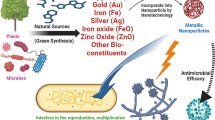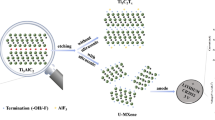Abstract
One of the biggest global threats to contemporary medicine and society at large is antibiotic resistance, which is also one of the least understood by professionals and the general public. Emerging crystalline materials called metal-organic frameworks (MOF) find extensive uses in biomedical engineering. Because of their excellent stability, and high porosity, MOFs are useful platforms for designing a variety of disinfectant agents against some pathogenic microbes that causing serious diseases. In this work, the effective hydrothermal synthesis of MIL-101(Cr) as a MOF substance was the main focus of originality and scientific value. Then, using a reduction-precipitation method, Fe2O3 material integrated the produced MOF structure. To synthesize the TiO2/Fe3O4/MIL-101(Cr) composite, we used a simple hydrothermal in situ growth technique. The XRD and HR-TEM analyses of the newly synthesized MOF-Fe2O3/TiO2 composite essentially confirmed its crystallinity and formation with the precise shape and size. Data clearly demonstrated that Candida albicans was the most susceptible organism to all three kinds of synthesized samples, with documented MIC values for MOF-Fe2O3/TiO2 at 62.5 µg mL− 1. Results further revealed that MOF-Fe2O3/TiO2 had the same MIC values of 62.5 µg mL− 1 against Staphylococcus aureus, and Bacillus subtilis. Positively, the amount of bacterial protein removed is directly proportional after increasing the concentration of MOF, MOF-Fe2O3, and MOF-Fe2O3/TiO2 and counted to be 99.89, 200.89, and 410.10 µg mL− 1 following the treatment with MOF, MOF-Fe2O3, and MOF-Fe2O3/TiO2, respectively. The promising results demonstrates the antibacterial features of the MOF-Fe2O3, and MOF-Fe2O3/TiO2 and describes the appearance of holes in the S. aureus membrane, which help in making the proteins bleed out from the S. aureus cytoplasm. Eventually, after irradiation with gamma dose (100.0 kGy), the potential antimicrobial activity of the synthesized MOF-Fe2O3/TiO2 was increased.









Similar content being viewed by others
Data Availability
The datasets used and/or analyzed during the current study are available from the corresponding author on reasonable request.
References
Y. Zhu, Q. Yang, Evolution of Multidrug-Resistant clinically important Bacteria and Fungi. Front. Microbiol. 13, 910364 (2022)
R. Mirghani et al., Biofilms: formation, drug resistance and alternatives to conventional approaches. AIMS Microbiol. 8(3), 239 (2022)
M.A. Salam et al., Antimicrobial Resistance: A Growing Serious Threat for Global Public Health. In Healthcare (MDPI, 2023)
A. Algammal et al., Emerging multidrug-resistant bacterial pathogens superbugs: a rising public health threat. Front. Microbiol. 14, 1135614 (2023)
M. Garvey, N.J. Rowan, Pathogenic drug resistant fungi: a review of mitigation strategies. Int. J. Mol. Sci. 24(2), 1584 (2023)
B. Mubeen et al., Nanotechnology as a novel approach in combating microbes providing an alternative to antibiotics. Antibiotics. 10(12), 1473 (2021)
V. Selvarajan, S. Obuobi, P.L.R. Ee, Silica nanoparticles—a versatile tool for the treatment of bacterial infections. Front. Chem. 8, 602 (2020)
D. Chenthamara et al., Therapeutic efficacy of nanoparticles and routes of administration. Biomaterials Res. 23(1), 1–29 (2019)
A. Karnwal et al., Perspectives on usage of functional nanomaterials in Antimicrobial Therapy for antibiotic-resistant bacterial infections. ACS Omega. 8(15), 13492–13508 (2023)
M. Teixeira et al., Advances in antibiotic nanotherapy: overcoming antimicrobial resistance. Emerg. Nanotechnologies Immunol., 2018: p. 233–259
P. Tan, H. Fu, X. Ma, Design, optimization, and nanotechnology of antimicrobial peptides: from exploration to applications. Nano Today. 39, 101229 (2021)
R.R. El-Behery, E.-S.R. El-Sayed, G.S. El-Sayyad, Gamma rays-assisted bacterial synthesis of bimetallic silver-selenium nanoparticles: powerful antimicrobial, antibiofilm, antioxidant, and photocatalytic activities. BMC Microbiol. 23(1), 224 (2023)
G.A. Govindasamy et al., Phytochemicals, biodegradation, cytocompatibility and wound healing profiles of chitosan film embedded green synthesized antibacterial ZnO/CuO nanocomposite. J. Polym. Environ. 31(10), 4393–4409 (2023)
F.M. Aldakheel et al., Silver nanoparticles loaded on Chitosan-g-PVA Hydrogel for the Wound-Healing applications. Molecules. 28(7), 3241 (2023)
N. Eldebany et al., Gelatin Loaded Titanium Dioxide and Silver Oxide Nanoparticles: Implication for Skin Tissue Regeneration (Biological Trace Element Research, 2020)
S. Gomaa et al., Accelerating wound healing: unveiling synergistic effects of P25/SWCNT/Ag and P25/rGO/Ag nanocomposites within PRP-gelatin scaffold, highlighting the synergistic antimicrobial activity. Biotechnol. J. 19(1), 2300531 (2024)
C.R. Mendes et al., Antibacterial action and target mechanisms of zinc oxide nanoparticles against bacterial pathogens. Sci. Rep. 12(1), 2658 (2022)
G.A. Govindasamy et al., Compositions and antimicrobial properties of binary ZnO–CuO nanocomposites encapsulated calcium and carbon from Calotropis gigantea targeted for skin pathogens. Sci. Rep. 11(1), 99 (2021)
M.F. Khan et al., Sol-gel synthesis of thorn-like ZnO nanoparticles endorsing mechanical stirring effect and their antimicrobial activities: potential role as nano-antibiotics. Sci. Rep. 6(1), 1–12 (2016)
M.F. Khan et al., Flower-shaped ZnO nanoparticles synthesized by a novel approach at near-room temperatures with antibacterial and antifungal properties. Int. J. Nanomed., 2014: p. 853–864
K. Umar et al., ZnO Nano-swirlings for azo dye AR183 photocatalytic degradation and antimycotic activity. Sci. Rep. 12(1), 14023 (2022)
El M.T. Sayed, A.S. El-Sayed, Biocidal activity of metal nanoparticles synthesized by Fusarium solani against multidrug-resistant bacteria and mycotoxigenic fungi. J. Microbiol. Biotechnol. 30(2), 226 (2020)
K. Punjabi et al., Efficiency of biosynthesized silver and zinc nanoparticles against multi-drug resistant pathogens. Front. Microbiol. 9, 2207 (2018)
D. Han, X. Liu, S. Wu, Metal organic framework-based antibacterial agents and their underlying mechanisms. Chem. Soc. Rev. 51(16), 7138–7169 (2022)
X. Zhang, F. Peng, D. Wang, MOFs and MOF-Derived materials for antibacterial application. J. Funct. Biomaterials. 13(4), 215 (2022)
J. Liu et al., Antibacterial mechanisms and applications of metal-organic frameworks and their derived nanomaterials. Trends Food Sci. Technol. 109, 413–434 (2021)
Y. Li et al., How effective are metal nanotherapeutic platforms against bacterial infections? A comprehensive review of literature. Int. J. Nanomed., 2023: p. 1109–1128
O. Lebedev et al., First direct imaging of giant pores of the metal – organic framework MIL-101. Chem. Mater. 17(26), 6525–6527 (2005)
T. Wang et al., Facile fabrication of Fe3O4/MIL-101 (cr) for effective removal of acid red 1 and orange G from aqueous solution. Chem. Eng. J. 295, 403–413 (2016)
C. Zhang et al., Titanium dioxide/magnetic metal-organic framework preparation for organic pollutants removal from water under visible light. Colloids Surf., a 589, 124484 (2020)
E.-S.R. El-Sayed, H.K. Abdelhakim, Z. Zakaria, Extracellular biosynthesis of cobalt ferrite nanoparticles by Monascus purpureus and their antioxidant, anticancer and antimicrobial activities: yield enhancement by gamma irradiation. Mater. Sci. Engineering: C 107, 110318 (2020)
A. Shahzaib et al., Multifunctional aspartic based MOF for reduction of methyl orange and antimicrobial activity. Catal. Lett., 2023: p. 1–12
N. Farzi et al., Antibacterial properties and efficacy of LL-37 fragment GF-17D3 and scolopendin A2 peptides against resistant clinical strains of Staphylococcus aureus, Pseudomonas aeruginosa, and Acinetobacter baumannii in vitro and in vivo model studies. Probiotics Antimicrob. Proteins, 2023: p. 1–19
W. Huang et al., Chemical analysis and in vitro antimicrobial effects and mechanism of action of Trachyspermum copticum essential oil against Escherichia coli. Asian Pac. J. Trop. Med. 10(7), 663–669 (2017)
H. Agarwal et al., Eco-friendly synthesis of zinc oxide nanoparticles using Cinnamomum Tamala leaf extract and its promising effect towards the antibacterial activity. J. Drug Deliv. Sci. Technol. 53, 101212 (2019)
M.S. Attia et al., Spirulina platensis-polysaccharides Promoted Green Silver Nanoparticles Production Using Gamma Radiation to suppress the expansion of Pear Fire Blight-Producing Erwinia amylovora. J. Cluster Sci. 30(4), 919–935 (2019)
M. Chen et al., Titanium incorporation into Zr-porphyrinic metal–organic frameworks with enhanced antibacterial activity against multidrug‐resistant pathogens. Small. 16(7), 1906240 (2020)
A.E. Salam, Antimicrobial activities of green synthesized ag nanoparticles@ Ni-MOF nanosheets. J. Inorg. Organomet. Polym Mater. 28, 2791–2798 (2018)
A.S. Abdelmoaty, A.A. El-Beih, A.A. Hanna, Synthesis, characterization and antimicrobial activity of copper-metal organic framework (Cu-MOF) and its modification by melamine. J. Inorg. Organomet. Polym Mater. 32(5), 1778–1785 (2022)
S.M. Sheta, S.R. Salem, S.M. El-Sheikh, A novel Iron (III)-based MOF: synthesis, characterization, biological, and antimicrobial activity study. J. Mater. Res. 37(14), 2356–2367 (2022)
A.I. El-Batal et al., Nystatin-mediated bismuth oxide nano-drug synthesis using gamma rays for increasing the antimicrobial and antibiofilm activities against some pathogenic bacteria and Candida species. RSC Adv. 10(16), 9274–9289 (2020)
M.A. Maksoud et al., MANanostructured mg substituted Mn-Zn ferrites: a magnetic recyclable catalyst for outstanding photocatalytic and antimicrobial potentials. J. Hazard. Mater., 2020: p. 123000
M.A. Maksoud et al., Influence of Mg2+ substitution on structural, optical, magnetic, and antimicrobial properties of Mn–Zn ferrite nanoparticles. J. Mater. Sci.: Mater. Electron. 31(3), 2598–2616 (2020)
R. Komal et al., Skirmishing MDR strain of Candida albicans by effective antifungal CeO2 nanostructures using Aspergillus terreus and Talaromycespurpurogenus. Mater. Res. Express. 7(5), 055004 (2020)
R.M. Fathy, A.Y. Mahfouz, Eco-friendly graphene oxide-based magnesium oxide nanocomposite synthesis using fungal fermented by-products and gamma rays for outstanding antimicrobial, antioxidant, and anticancer activities Journal of Nanostructure in Chemistry: pp. 1–21
A. Joe et al., Antimicrobial activity of ZnO nanoplates and its Ag nanocomposites: insight into an ROS-mediated antibacterial mechanism under UV light. J. Solid State Chem. 267, 124–133 (2018)
N. Bradford, A rapid and sensitive method for the quantitation microgram quantities of a protein isolated from red cell membranes. Anal. Biochem. 72(248), e254 (1976)
S. Rajesh, V. Dharanishanthi, A.V. Kanna, Antibacterial mechanism of biogenic silver nanoparticles of Lactobacillus acidophilus. J. Exp. Nanosci. 10(15), 1143–1152 (2015)
Z. Azam et al., Microbial synthesized cadmium oxide nanoparticles induce oxidative stress and protein leakage in bacterial cells. Microb. Pathog. 144, 104188 (2020)
M.B. Ali et al., Effect of zinc concentration on the structural and magnetic properties of mixed Co–Zn ferrites nanoparticles synthesized by sol/gel method. J. Magn. Magn. Mater. 398, 20–25 (2016)
M. Veena et al., Effect of 60 Co gamma irradiation on dielectric and complex impedance properties of Dy 3 + substituted Ni–Zn nanoferrites. J. Magn. Magn. Mater. 419, 375–385 (2016)
H.S. El-Bastawisy, G.S. El-Sayyad, F.A. Abu Safe, Detection of hemolytic Shiga toxin-producing Escherichia coli in fresh vegetables and efficiency of phytogenically synthesized silver nanoparticles by Syzygium aromaticum extract and gamma radiation against isolated pathogens. BMC Microbiol. 23(1), 262 (2023)
M.D. Firouzjaei et al., A novel nanocomposite with superior antibacterial activity: a silver-based metal organic framework embellished with graphene oxide. Adv. Mater. Interfaces. 5(11), 1701365 (2018)
R. Li, T. Chen, X. Pan, Metal–organic-framework-based materials for antimicrobial applications. ACS nano. 15(3), 3808–3848 (2021)
M.M. Francis et al., Fabricating effective heterojunction in metal-organic framework-derived self-cleanable and dark/visible-light dual mode antimicrobial CuO/AgX (X = cl, br, or I) nanocomposites. Chem. Eng. J. 446, 137363 (2022)
M.A. Maksoud et al., Antibacterial and antibiofilm activities of silver-decorated zinc ferrite nanoparticles synthesized by a gamma irradiation-coupled sol–gel method against some pathogenic bacteria from medical operating room surfaces. RSC Adv. 11(45), 28361–28374 (2021)
Acknowledgements
The authors thanks National Center for Radiation Research and Technology (NCRRT), Egyptian Atomic Energy Authority (EAEA) for the possibility to use their equipment and facilities during gamma irradiation process.
Funding
This research did not receive any specific grants from public, commercial, or private funding agencies.
Author information
Authors and Affiliations
Contributions
MA: Suggested the research topic, investigated the article, planned the research methodology, wrote the original draft, and participated in data representation and article revising and editing. SSA: Suggested the research topic, investigated the article, planned the research methodology, wrote the original draft, and participated in data representation and article revising and editing. GSE: Suggested the research topic, investigated the article, planned the research methodology, wrote the original draft, and participated in data representation and article revising and editing.
Corresponding author
Ethics declarations
Ethics Approval and Consent to Participate
This article does not contain any studies with human or animal subjects.
Consent for publication
Not applicable.
Competing Interests
There was no conflict of interest in this study.
Additional information
Publisher’s Note
Springer Nature remains neutral with regard to jurisdictional claims in published maps and institutional affiliations.
Rights and permissions
Springer Nature or its licensor (e.g. a society or other partner) holds exclusive rights to this article under a publishing agreement with the author(s) or other rightsholder(s); author self-archiving of the accepted manuscript version of this article is solely governed by the terms of such publishing agreement and applicable law.
About this article
Cite this article
Abd Elkodous, M., Abdel-Fatah, S.S. & El-Sayyad, G.S. Gamma-Rays Empowered the Antimicrobial Potential of TiO2/Fe3O4/MIL-101(Cr) Nanocomposite against Drug-Resistant Bacteria and Pathogenic Fungi. J Inorg Organomet Polym (2024). https://doi.org/10.1007/s10904-024-03076-6
Received:
Accepted:
Published:
DOI: https://doi.org/10.1007/s10904-024-03076-6




